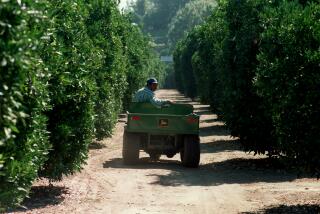If the Swiss and German immigrants who...
- Share via
If the Swiss and German immigrants who founded Palmdale in 1886 had been better botanists, their city probably would have been called Joshua City.
The newcomers who settled in the rough and arid Antelope Valley mistook the abounding Joshua trees for palm trees and called their new town Palmenthal, later changed to Palmdale.
A century later, Palmdale became the Antelope Valley’s first city and the High Desert home of aerospace--but not the host of a huge intercontinental airport that boosters once envisioned.
It is the fastest-growing community in the country--and the nation’s foreclosure capital. Countering the sound of hammers thumping at wood-frame houses is the sound of the desert wind rattling the “For Sale” signs across the landscape.
Palmdale has seen the best of Southern California booms and the worst of the busts in its 110 years. Its first land boom came in 1876 when the Southern Pacific laid tracks, immediately doubling the price of land--from 25 to 50 cents an acre.
Legendary westerners Wyatt Earp and Kit Carson spent time in the High Desert, but the 20th century’s risk takers, among them fabled pilot Chuck Yeager, took on the frontier of space.
Space and flight can be credited with creating the raw new suburb of Palmdale. The nation’s entry into World War II brought many servicemen to work at Edwards Air Force Base, then known as Muroc Army Air Base. And the working and middle-class employees at defense plants operating here throughout World War II and the Cold War spent government paychecks on mortgage payments in what would later become known as the aerospace capital of the United States.
But one aerospace vision never got off the ground--plans for a successor to Los Angeles International Airport. After Palmdale incorporated in 1962, ideas for a giant intercontinental airport began to take shape. A high-speed monorail could shuttle pas-
sengers between Los Angeles and the airport, through a tunnel to be bored through the San Gabriel Mountains.
In 1968, the Los Angeles Department of Airports paid $16 million for almost 18,000 acres of empty land--about five times the area of the Los Angeles airport. But by the mid-1970s, Palmdale was judged too remote, so now jack rabbits and pistachio groves and not jumbo jets occupy the city’s land.
Airport or no, Palmdale grew anyway. It was dubbed “the next San Fernando Valley” in the late 1980s, when soaring urban housing prices pushed young families out to affordable suburbs such as Palmdale. Buyers camped overnight for a chance to buy the houses, even though the trade-off was long, exhausting commutes.
But in the early 1990s, the aerospace downturn hit with a vengeance. Thousands of jobs were lost and the housing market plunged.
Today, Palmdale residents are hoping to climb to new heights of prosperity with the creation of 4,500 jobs--about half from a vast new textile and clothing business and the other half from aerospace, when Lockheed Martin Corp. begins work on the prototype X-33 reusable spacecraft.
(BEGIN TEXT OF INFOBOX / INFOGRAPHIC)
By The Numbers
City Business
Incorporated: Aug. 24, 1962
Square miles: 102
Number of city parks: 8
Ciy employees: 196 full time; 329 part time
1995-96 budget: $35 million
*
People
Population: 68,917
Households: 22,010
Average household size: 3
Median age: 28
*
Ethnic Breakdown
Asian: 4%
Black: 6%
Latino: 22%
White: 67%
Other: 1%
*
Money and Work Median household income: $41,974
Median household income / L.A. County: $34,965
Median home value: $149,500
Employed workers (16 and older): 33,287
Percentage of women employed: 59%
Percentage of men employed: 85%
Self-employed: 1,937
Car- poolers: 7,076
*
Retail Stores
Number of stores: 399
Number of employees: 4,348
Annual sales: $510 million
*
Families:
Married couples with children: 45%
Married couples with no children: 22%
Non-family households: 20%
Other types of families: 13%
Source: Claritas Inc. Household expenses are averages for 1994. All other figures are for 1990. Percentages have been rounded to the nearest whole number.
More to Read
Inside the business of entertainment
The Wide Shot brings you news, analysis and insights on everything from streaming wars to production — and what it all means for the future.
You may occasionally receive promotional content from the Los Angeles Times.










